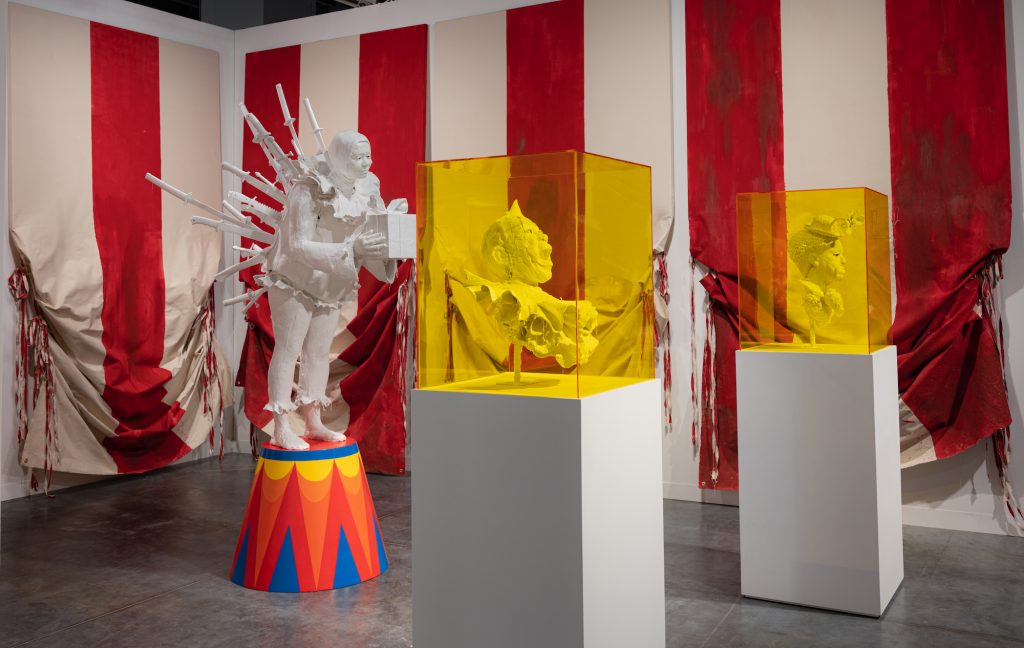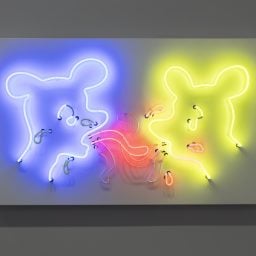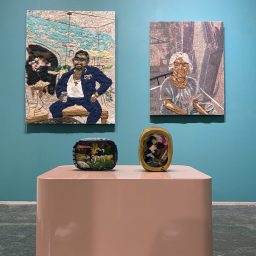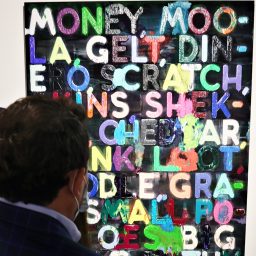There are three types of fairgoers.
First, you have the go-with-the-flow-er—the person who enters an art fair with no specific itinerary and wanders the aisles to see what moves them. (You might find that the Venn Diagram between go-with-the-flow fairgoers and people with more than 1,000 unread emails in their inbox is a circle.)
Then, there’s the sharpshooter: someone who steps onto the floor with a marked-up map of booths to hit in a highly optimized order. (This person has probably reached inbox zero.) Finally, you have the optimist. This individual begins with a plan to proceed aisle by aisle, booth by booth, only to burn out about a third of the way through. They usually devolve into a go-with-the-flow-er on the way out the door.
Tasked with finding the best booths at this year’s Art Basel Miami Beach, a fair with no fewer than 253 participating galleries, I realized none of these approaches was going to work. So I opted to divide and conquer. Over the course of six and a half hours, I hit up the fair’s four main sections—Galleries, Nova, Positions, and Survey—and chose one can’t-miss booth from each (plus one extra from the galleries section, which is by far the largest).
Here are my picks. If you plan to tackle the fair this weekend, I hope they bring a bit of sharpshooter energy to your visit.
Daniel Faria Gallery
Toronto
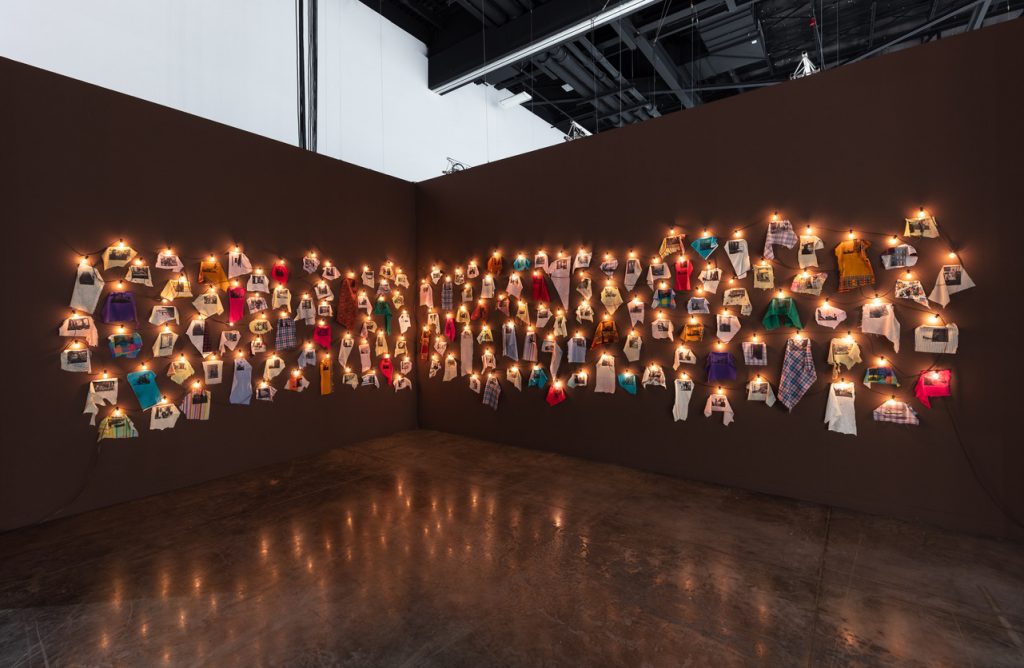
June Clark’s Harlem Quilt (1997) at Daniel Faria’s booth at Art Basel Miami Beach 2021. Photo: Silvia Ros.
In 1997, during a residency at the Studio Museum in Harlem, the artist June Clark took her camera out onto the streets and photographed residents as they napped on the subway, waited at a crosswalk, and crowded around shop windows. Using the same kind of transfer process one might use to personalize a t-shirt, she printed the images on scraps of fabric she collected from Goodwill. “She imagined that someone in the images may have owned the clothes she printed them on,” said the gallery’s director, Madeleine Taurins.
The result is an installation that doubles as a deconstructed quilt and an intimate portrait of a neighborhood. There is a kind of alchemy in the simple materials—cloth, lightbulbs—that turns down the volume outside the booth and encourages you to actually look.
Before its debut in Survey (Art Basel’s section for historical solo projects), Harlem Quilt had only been shown once before, during Clark’s residency exhibition 24 years ago at the Studio Museum. While the artist is gaining recognition in her adopted home country of Canada, where she has lived since the 1960s (her work is in the collections of the National Gallery of Canada and the Art Gallery of Ontario), she remains lesser-known in the U.S. Hopefully, her memorable showing at the fair will change that. The installation is on offer for between $250,000 and $300,000.
Wilding Cran Gallery
Los Angeles

Karon Davis, Tragedy at Wilding Cran’s booth at Art Basel Miami Beach. Photo courtesy of the artist and the gallery.
Art-world denizens often joke that art fairs are like a traveling circus—the same people in the same tent plopping down in city after city. That’s why Karon Davis’s installation in the Positions section (which is dedicated to solo presentations by young galleries) feels particularly apt. The Los Angeles-based artist, who also has a number of works on view this week at the Rubell Museum, created three sculptures of circus performers against a suite of paintings designed to recall a big-top tent.
The display might feel gimmicky if there weren’t so much pathos in it. The central figure, based on a cast of Davis’s own body, stands on a plinth with a gift in her hands and more than a dozen knives in her back. One of the busts—based on her father, the famous Broadway performer Ben Vereen—is captured with his mouth agape, as if he has been frozen mid-scream. (He is Tragedy; the other sculpture is Comedy.) The paintings, which represent Davis’s first foray into the medium, have been dirtied with sand and patched to make them look weary, as if they have lived a life on the road.
The gallery is offering the sculptures and paintings in groups to keep the feel of the installation intact. As of Tuesday afternoon, the central sculpture had sold with two canvases for $150,000, while the other two works, which come with one canvas each, were on hold for $85,000 apiece.
Peter Blum
New York
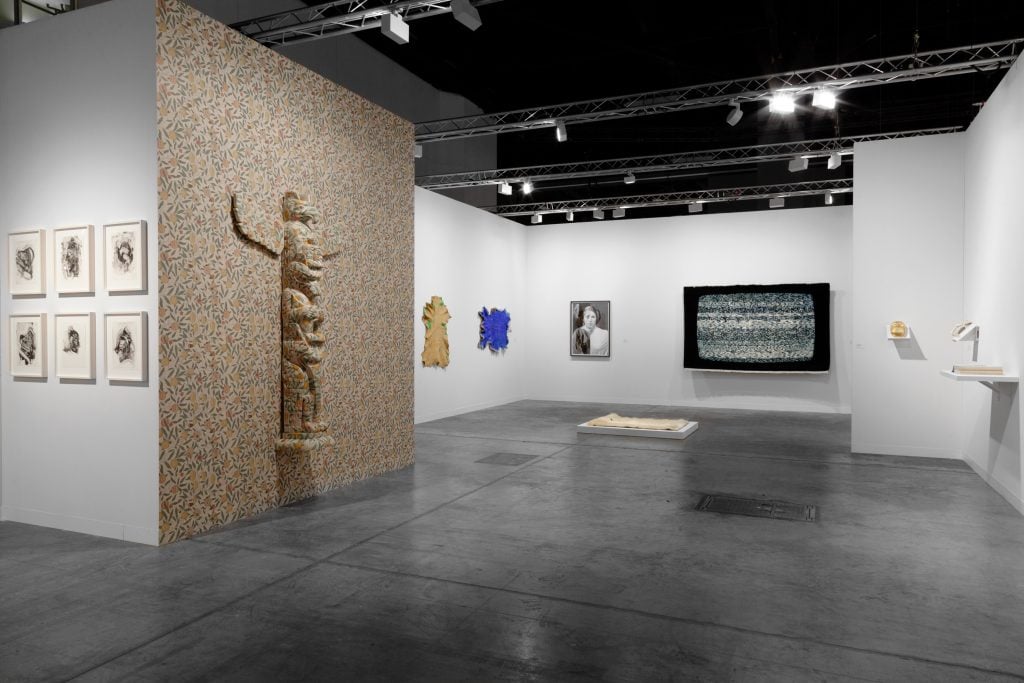
Installation view, Peter Blum’s solo booth of Nicholas Galanin at Art Basel Miami Beach. Photo courtesy of the gallery.
For a gallery in the main section of the fair, it’s customary—and often lucrative—to present an array of crowd-pleasing works by a range of artists in the program. Peter Blum’s booth went against the grain.
At first, it might seem like a group display, with media ranging from wallpaper to photography to tapestry. But upon closer inspection, it becomes clear that the works are all by the same artist: the Alaska-based Nicholas Galanin. Created over the course of 12 years, each one explores—sometimes wittily, often profoundly—how white America has appropriated Native land and culture, often distorting history and disfiguring itself in the process.
One particularly resonant work by the Tlingit and Unangax̂ artist is The Imaginary Indian (Totem Pole) (2016), a carved totem installed in front of Victorian-era wallpaper and hand-painted to blend right in. For Galanin, the work represents the European fetishization, appropriation, and flattening of Native cultural production.
Works on the stand range in price from $10,000 for small-scale editions to $135,000. Around half of the works on offer were sold by the end of the first VIP day.
Esther Schipper
Berlin
Installation view of Esther Schipper’s booth at Art Basel Miami Beach 2021. Courtesy of the artists and Esther Schipper, Berlin. Photo © Sebastiano Pellion di Persano
When I think of people with a good sense of humor, the Germans aren’t necessarily at the top of my list. But the Berlin gallery Esther Schipper may have the most cheeky, lighthearted, and fun booth in the main section. The gallery installed a range of works that evoke a candy-colored funhouse—a window sculpture by Ryan Gander, an illuminated suspended marquee by Philippe Parreno, a bench (that you are actually allowed to sit on!) by Liam Gillick. There’s even an aluminum curtain by the Spanish artist Daniel Steegmann Mangrané that conveniently serves to create a small oasis for the gallery’s dealers, who are stationed behind it.
Perhaps the most delightful inhabitant of the stand is a series of new works by Simon Fujiwara that chronicle the adventures of a character called Who the Baer (yes, that spelling is intentional). This baer is a cartoon character who travels Google and pops into various art-world images to try on different personas. (In one series, the baer makes their way through the Met to give some commentary about restitution.) Part of the series premiered at the Prada Foundation earlier this year; it will be the subject of a solo show at Esther Schipper in January. Two of the three “Baer” works on offer sold at prices ranging from $20,000 to $35,000 each by the end of the first VIP preview day.
First Floor Harare
Harare
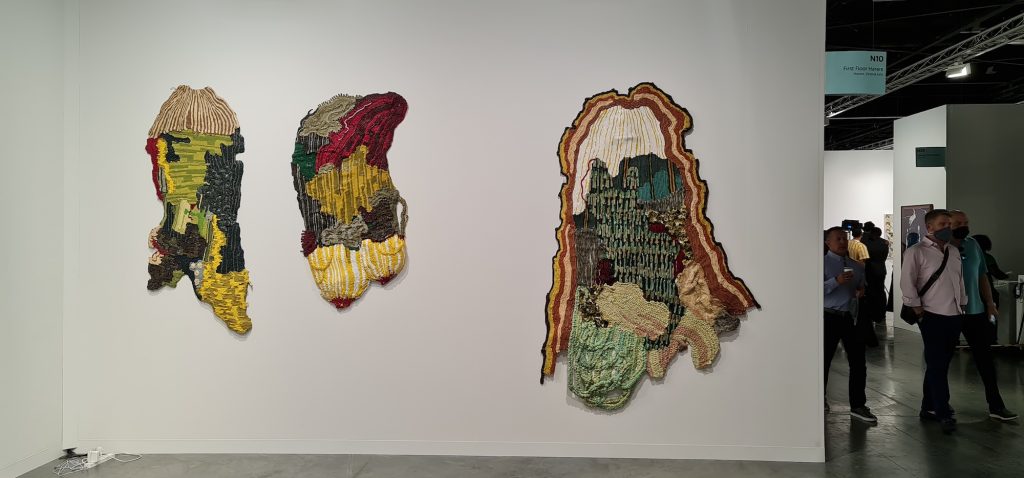
Works by Troy Makeza at Art Basel Miami Beach. Courtesy of the artist and First Floor Gallery Harare.
I know, I know—we’re not supposed to touch the art. But if I were given special dispensation to touch any work on view at all of Art Basel Miami Beach, I would choose these luscious, tactile works by Zimbabwean artist Troy Makaza, on view at First Floor Harare’s stand in the Nova section, which is dedicated to art made within the past three years.
Created with paint-dyed silicone, they are somewhere in between painting and sculpture, with varied textures that evoke textiles and topographical maps. “Maps are about power and determination of access,” gallery director Marcus Gora noted. For a young artist in Zimbabwe, “commenting on a political situation in abstraction is easier because it doesn’t immediately offend.”
The process is labor intensive: Makaza creates them by piping the silicone out of a bag like frosting or rolling it like hand-pulled noodles. At only 27 years old, the artist is already beginning to develop an international profile. His work has been shown at Zietz MOCAA in Cape Town and the Depart Foundation in Los Angeles; it’s now in the collection of Miami patron Jorge Pérez. At the fair, three of his works had sold by mid-afternoon on VIP day at prices ranging from $8,000 to $18,000.
